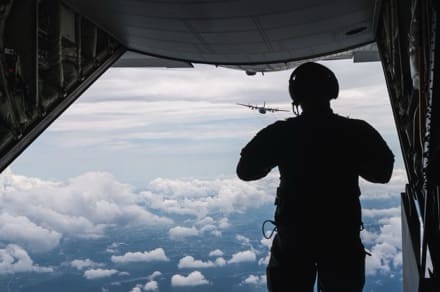
KUNSAN AIR BASE, South Korea (AFNS) —
South Korea’s summers are well-known for cloudy skies and torrential downpours that will seem at a second’s discover. Nevertheless, throughout per week in mid-July, members of the Wolf Pack at Kunsan Air Base noticed a spectacle precipitate from the open skies in contrast to the everyday monsoon rains.
Spectators all through the set up may spot paratroopers descending from the sky onto a drop zone close to the bottom’s alternate touchdown space, delivered by a U.S. MC-130J Commando II and a Republic of Korea air pressure MC-130K Hercules flying in formation collectively.
The practically three-week, multinational coaching referred to as Joint Mixed Change Coaching, was hosted by the Particular Operations Command Korea from July 15-31.
The objective of the coaching was to make sure interoperability with coalition particular operations forces companions in sensible coaching environments. To do that, mission organizers created difficult situations in several domains to duplicate adversarial ways in fight situations.



“Joint Mixed Change Coaching is the place USAF SOF practice alongside our ROK SOF counterparts to rehearse mission important duties whereas enhancing our lethality,” stated U.S. Air Power Capt. Raymond Lessig, 320th Particular Techniques Squadron drop zone controller and mission commander. “The coaching offered alternatives for U.S. and ROK SOF to work via language limitations, change ways strategies and procedures, and acquire a greater understanding of our collective strengths and weaknesses in order that we are able to higher leverage one another’s capabilities throughout real-world contingency operations.”
As the one theater particular operations command by which the U.S. and host-nation SOF are institutionally organized for mixed operations, SOCKOR and aligned items repeatedly practice with their counterparts within the ROK military particular warfare command, air mobility and reconnaissance command, naval particular warfare flotilla command, and different items.
To efficiently accomplish the coaching, planners relied closely on the coordination between the eighth Fighter Wing, SOCKOR, the 353rd Particular Operations Wing, ROK AMRC, and the 51st Fighter Wing at Osan Air Base. Every unit performed a complementary function in reaching desired coaching goals. All through the second week, individuals utilized Kunsan AB to conduct the bounce coaching portion of the JCET.
“That is the fourth 12 months we’ve carried out this coaching at Kunsan,” Lessig stated. “We preserve selecting to return again due to how accommodating and useful the Wolf Pack has been. Every facet of Kunsan from airfield administration to the medical group have been able to help our staff execute this high-value coaching.”
The flexibility to just accept follow-on forces is without doubt one of the key tenets of the Wolf Pack’s core mission and was on full show through the weeklong coaching on Kunsan AB. In keeping with U.S. Air Power Col. Peter Kasarskis, eighth Fighter Wing commander, that is what makes Kunsan such an important asset in optimizing U.S. Forces Korea’s agility and talent to venture airpower all through Asia.
“Kunsan exemplifies readiness within the Indo-Pacific,” Kasarskis stated. “Our Airmen right here on the Wolf Pack exhibit day by day what it means to be forward-deployed and able to combat tonight. Supporting coaching, just like the JCET, highlights our capacity to quickly obtain follow-on missions and combine with allies and companions. Kunsan is greater than only a fighter base; it’s an agile energy projection platform prepared for any mission.”
Lessig stated Kunsan’s location additionally made the distinction in guaranteeing this iteration of the coaching was as consultant of potential real-world situations as doable.
“Kunsan’s location is invaluable to creating sensible coaching circumstances,” Lessig stated. “Its location, surrounding atmosphere and mission set, forces individuals to plan and rehearse airborne operations removed from their desired touchdown space, probably at evening and in hostile climate circumstances, and to soundly navigate as a staff with all fight gear to their goal.”
As this portion of the JCET ends, the occasion showcased the navy partnership between the U.S. and ROK forces, serving as a robust reminder of their unwavering dedication to regional safety. Nevertheless, for some, this occasion was greater than only a testomony to their energy; it was a once-in-a-lifetime alternative to witness the seamless interoperability of two of the world’s most formidable navy forces.
Story by MSgt Michael Charles, eighth Fighter Wing Public Affairs
Images by Senior Airman James Johnson
Each feedback and pings are presently closed.



